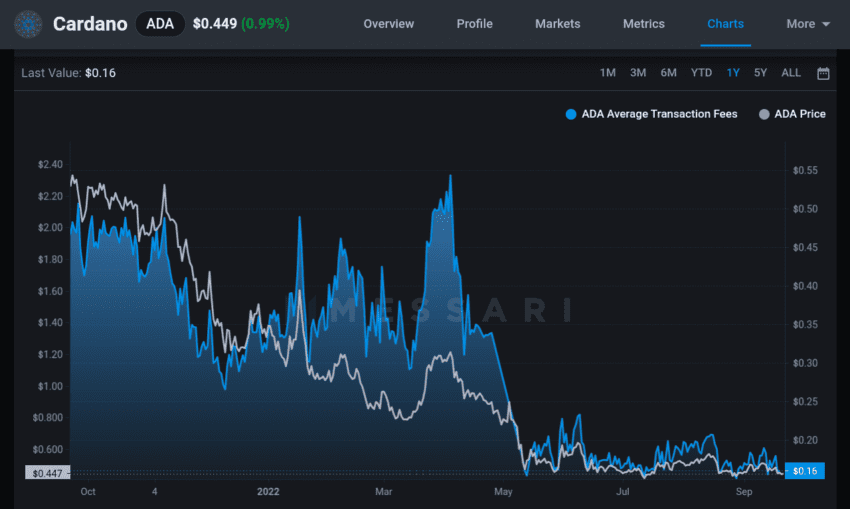Cardano’s (ADA) blockchain is set for the Vasil Hard Fork upgrade on Sept. 22. Named in honor of Cardano community member, Vasil St. Dabov, who passed on in 2021, the much-anticipated upgrade is expected to bring about sweeping changes to the network, impacting transaction fees, speed and decentralized application development.
Founded by Charles Hoskinson in 2015, Cardano is a peer-to-peer blockchain that aims to overcome common cryptocurrency issues in the areas of scalability, interoperability, and other regulatory dilemmas. Transactions are settled via the network’s native ADA token, now the eighth largest crypto asset by market capitalization, valued at $15.39 billion.
And since Hoskinson is also co-founder of Ethereum, which had an upgrade of its own last week, it has been hard for Cardano to escape frequent, and often uncharitable comparison, with one of its biggest rival blockchains. There’s little doubt many in the ADA camp have been miffed by what they consider a delay on Cardano’s past promises. But that may now be changing.
What is the Vasil Hard Fork Upgrade?
A hard fork represents a complete change to a network’s protocol and creates a permanent divergence from the previous version of the blockchain, according to the online financial dictionary Investopedia. Most recently, some miners on Ethereum opted to remain with the old version of the network when it ‘Merged’ on Sept.15. They “forked”, or split, the Ethereum blockchain.
Initially scheduled for June or July, the Vasil upgrade is part of Cardano’s third development cycle designed to improve network capacity, lower transaction fees, and make transactions faster. It will bring a slew of major changes to the blockchain, making it more user/developer friendly for smart contracts and dApps development.
Vasil is considered by developers at Input Output Global (IOG) as the “most extensive upgrade attempted” to Cardano to date, “touching every layer of the network stack” and fixing a lot of bugs. Input Output is a development lab that helps maintain the Cardano blockchain.
Transaction costs
The final result of the update will signal an increase in the size of the block, and give more space to data to be saved into each block added to the ledger, says the Cardano Foundation, which oversees the development on the blockchain.
The significance of the improvements on blocks is to make transaction sizes smaller, which increases network throughput while cutting transaction fees, explained Tim Harrison, VP of community and ecosystem at IOG.
According to Messari, it currently costs an average price of $0.16 to send a transaction over the ADA blockchain, one of the lowest fees in the industry. Vasil is expected to make that even cheaper.
Network scalability
Vasil is expected to bring numerous upgrades to network capacity and Cardano’s smart contract programming language Plutus, which enables the development of decentralized applications, or dApps, on the blockchain.
Cardano has been dogged by problems that have hindered the capacity of dApps to scale. Currently, there are more than 1,000 dApps running on Cardano, according to the Foundation website. Over 40% of the decentralized applications are focused on non-fungible tokens.
Notably, dApps built on Cardano are programmed using a language called Haskell, a code that is then converted into Plutus. The Plutus data is not stored on the blockchain. It means “every time a transaction is made, it needs to carry all the application logic along with it.” But more data slows down performance and increases costs.
Transaction speeds
According to Harrison, Vasil will allow developers to store and reference information without having to use output. This is expected to help “optimize transaction throughput and increase the concurrency of the Cardano blockchain.” As a result, transaction speeds are forecast to improve on the current time of about 20 seconds.
When is the upgrade?
Previously scheduled for July, Cardano’s Vasil upgrade has now been confirmed to take place on Sept. 22. Founder Charles Hoskinson revealed earlier last week that the Vasil hard fork implementation was now in its final stage.
Input Output also announced that “the numbers are looking good for 22nd September, hence the date for the mainnet upgrade has been agreed.” Already, dozens of exchanges, including Binance, have signaled support for Vasil.
Will the Vasil upgrade affect ADA price?
Yes. But it is hard to workout how exactly the asset will react. That’s because Vasil is somewhat different in that “it is the only hard fork in the history of Cardano to occur during a bear market.” Its predecessors – Shelley, Mary and Alonzo – inevitably affected ADA’s price action. Prices rallied leading up to the upgrades, but later lost steam.
The same could hold true for the Vasil fork, say analysts, with prices already reacting with a small rally after Hoskinson revealed the date that the upgrade would go live. ADA soared about 9% to $0.49 at the time, on Sept. 2.
ADA is up about 1% to $0.45, as of writing. The asset has plunged more than 85% since its all-time high of $3.09 reached on Sept. 2, 2021, according to CoinGecko.
For Be[In]Crypto’s latest Bitcoin (BTC) analysis, click here.
Disclaimer
All the information contained on our website is published in good faith and for general information purposes only. Any action the reader takes upon the information found on our website is strictly at their own risk.


